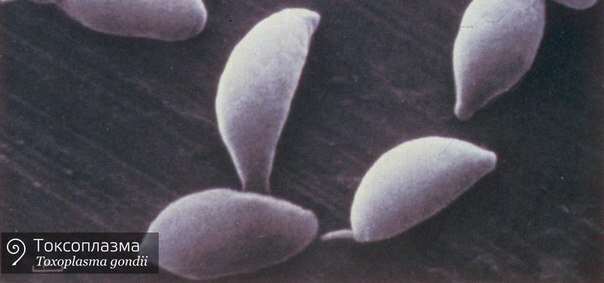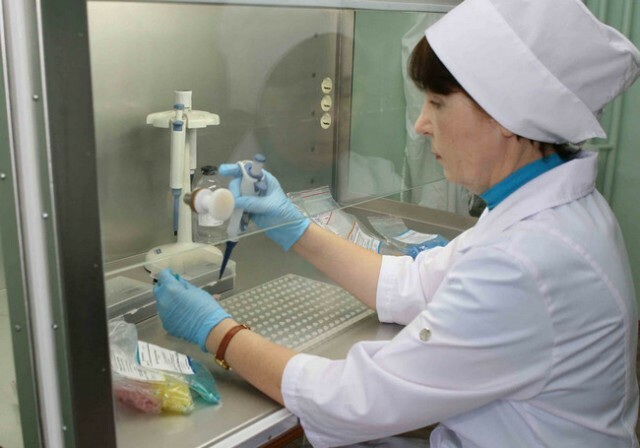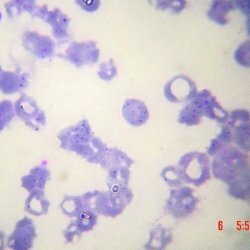Toxoplasmosis: Symptoms, Causes, Diagnosis and Treatment
 Toxoplasmosis is classified as a group of parasitic pathologies, because its causative agent, Gondi's toxoplasm, is the simplest.This microorganism primarily affects the nervous and muscular system, as well as the eyes, the heart, lymph nodes, and other internal organs.
Toxoplasmosis is classified as a group of parasitic pathologies, because its causative agent, Gondi's toxoplasm, is the simplest.This microorganism primarily affects the nervous and muscular system, as well as the eyes, the heart, lymph nodes, and other internal organs.
This disease is very common on the planet, especially many cases of infection( up to 90% of the population) are found in Africa and South America.In Europe, the infection rate is 20-50%.The most common cause of toxoplasmosis infection is pets, namely cats, many cases of infection and as a result of improperly prepared meat.
Table of contents: Paths of toxoplasmosis Toxoplasmosis Toxoplasmosis SymptomsPaths of infection with toxoplasmosis

Note: toxoplasmosis tends to be chronic, and its symptomatology is not always pronounced.The greatest danger it makes for women in the situation, so is able to provoke a future child a number of severe deformities.
The infection with this parasitic disease can result in:
- consuming meat, eggs without the necessary heat treatment;
- blood transfusion;
- ingestion of toxoplasm on mucous membranes, wounds on the skin;
- intrauterine infection;
- organ transplant;
- unwashed hands after cleaning the cat's toilet, contact with the ground can be a source of infection;Contact with raw meat.
- .

Getting into the human body, toxoplasm begins to multiply actively in the intestine, from where it spreads to all organs with blood and lymph flow.Initially, the disease spreads through the lymph, so the patient can find enlarged lymph nodes.Then follows hematogenous dissimination, but in the blood of toxoplasm is very short - up to several days.It provokes an inflammatory process in internal organs and systems, where this protozoan is already at the intracellular level.Parasites accumulate in the form of so-called pseudocysts, and the disease passes into the latent phase.Activation of the disease is possible in case of a decrease in immunity against the background of another pathology.Pathogenesis of nervous system damage by toxoplasmosis is a focal inflammation in the form of necrotizing type encephalitis, a discirculatory disorder.It is for children in the womb that toxoplasmosis is most dangerous, the brain suffers more than other organs( microcephaly, hydrocephalus).
Kinds of toxoplasmosis
Depending on the time of infection, toxoplasmosis is divided into:
- acquired - the patient becomes infected during life;
- congenital is different in that it infects the fetus from the mother in utero( this is fraught with severe deformities and even lethal outcome).
Acquired toxoplasmosis, in its turn, is divided into:
- chronic - the clinic grows gradually, the signs of the disease are not noticeable;
- acute form - this is always a sharp beginning with severe symptoms.
Toxoplasmosis is also classified with respect to the affected organ system into the following types:
- meningoencephalic( nervous system damage, complaints of headaches);
- ophthalmic with visual impairment;
- is lymphonodular, in which there are enlarged lymph nodes;
- generalized when there is a defeat of several systems;
- cardiac - with attacks of shortness of breath, general weakness and pain in the heart.
Symptoms of toxoplasmosis
Very often the patient does not know about his disease, since toxoplasmosis tends to be latent.
In acute form of toxoplasmosis, patients complain of such symptoms:
- enlarged lymph nodes;
- headache;
- convulsive state;
- temperature rise up to 39 ° C;
- nausea;
- problems with eyesight: from double vision in the eyes to complete blindness;
- vomiting;
- enlargement of the liver with palpation, as well as spleen.
Signs of chronic toxoplasmosis often become:
- headache;
- reduced performance;
- a subfebrile condition at which the body temperature keeps within the limits of 37 - 37,5 ° С;
- causeless fatigue;
- weakness in the body;
- enlargement of lymph nodes that can be palpated.
Signs of toxoplasmosis appear after the end of the incubation period, which lasts depending on the mode of infection of 5 days( infection through feces of cats) or 2-3 weeks( when consuming poorly thermally processed meat).If there is an asymptomatic course, the incubation period may be longer.
Symptoms of toxoplasmosis in cats
In animals, this parasite can cause only temporary deterioration of the condition, which is manifested by the following symptoms:
- mild rhinitis;
- discharge from the eyes in a small volume;
- vomiting and diarrhea, which are of a single character.
 It should be more attentive to domestic cats.After all, very often toxoplasmosis in cats is taken for an ordinary cold or poisoning.Already after 2 or 3 days the cat will be healthy, and the disease will go into a latent, and then into a chronic form.If the animal is healthy, then its immunity does not allow toxoplasm to reproduce and locks them in cages.After this, it is important not to allow a second infection.
It should be more attentive to domestic cats.After all, very often toxoplasmosis in cats is taken for an ordinary cold or poisoning.Already after 2 or 3 days the cat will be healthy, and the disease will go into a latent, and then into a chronic form.If the animal is healthy, then its immunity does not allow toxoplasm to reproduce and locks them in cages.After this, it is important not to allow a second infection.
Please note: it is that cats become the main cause of infection with toxoplasma, so a pregnant woman and children should refuse contact with them.
Toxoplasmosis in pregnancy
Toxoplasmosis in pregnancy is primarily a danger to the baby in the womb of the mother.
Symptoms of this infection may include:
- complaints of headache;
- constant fatigue;
- body temperature rise to subfebrile digits;
- pain syndrome( muscles, joints);
- enlarged lymph nodes.
Toxoplasmosis is indeed very dangerous, but it occurs in pregnant women only in 1% of cases.Moreover, not every woman who has been infected with toxoplasma, is infected with the fetus.The greatest risk is the first 12 weeks of pregnancy, when the embryo can not withstand toxoplasm.In most cases, such a pregnancy ends in a miscarriage.When a woman becomes infected at a later date, there is a high risk of toxoplasma damage to the vital organs of the newborn.
Important : if toxoplasmosis in pregnancy is determined at the initial stage of development, then treatment is allowed that reduces the risk of defects in the fetus.
Toxoplasmosis in children
It is proven that in childhood infestation of toxoplasma in a small amount tends to a favorable prognosis.In this case, the parasite in the body of the child is covered with a shell and becomes harmless, which is ensured by the work of immunity.That is why very often the signs of toxoplasmosis in children have an erased character, and complications are practically not found.
The acute form of the disease in children is accompanied by a slightly different clinical picture:
-
 subfebrile;
subfebrile; - drowsiness;
- problems in the work of the spleen and liver;
- jaundice;
- weakness in the body;
- enlarged lymph nodes;
- problems with eyesight;
- rash on the body.
For more information about the symptoms, methods of diagnosis and treatment of toxoplasmosis in children, see this video review by Dr. Komarovsky:
Diagnosis of toxoplasmosis
To confirm the diagnosis, the physician assigns a series of tests to the patient that will determine whether the parasite is present in the blood orAntibodies to toxoplasmosis.
The survey plan includes:
- Anamnesis history.The doctor asks about the complaints that disturb the patient: general weakness, subfebrile condition, headache, lymph node enlargement, vision problems.The prescription of symptoms is also taken into account.The doctor asks about the presence of the house of animals, bad habits, working conditions, food preferences.
- Laboratory research.
Laboratory tests for the diagnosis of toxoplasmosis may include:
- General blood test.In it, evidence of inflammatory changes in the body will be found.Biochemical analysis of blood.
- .With toxoplasmosis, he shows signs of impaired liver function.
- Bloodsucking.This analysis on toxoplasmosis makes it possible to determine the presence of parasites that begin to actively grow on a special environment favorable for them.
- Immunoenzyme analysis for antibodies to toxoplasmosis.It is believed that the patient is sick with toxoplasmosis, if there is a positive IgG titer, and additional studies are prescribed for such a patient.The presence of specific antibodies suggests that the patient's immunity is fighting this infection.This analysis is especially important during pregnancy and before its planning!
- PCR.This is a very accurate technique of polymerase chain reaction, in which the blood is examined for toxoplasmosis.In the presence of toxoplasmosis in the material taken, the genes of the parasite are detected.
- Reaction with toxoplasmine.The patient under the skin is injected with a weakened agent of toxoplasmosis and observes the reaction: if there is redness and swelling at the injection site, the result is positive, that is, the body already has this infection.The absence of changes suggests that a person has never experienced toxoplasm.
On the rules of interpretation of the analysis for the presence of antibodies to toxoplasmosis - in the video review:
Important : should not try to decipher the tests for toxoplasmosis independently, because without the necessary knowledge and education, the patient can make wrong conclusions.
Toxoplasmosis: treatment
The therapeutic regimen is made only by the doctor, and ideally the treatment of toxoplasmosis should be performed in the hospital, but this only applies when there is a pronounced clinic of the disease in weakened patients with concomitant pathologies.
Note: should be aware that chronic toxoplasmosis is very rarely treatable.
The treatment regimen includes, as a rule, preparations from such groups:
-
 chemotherapeutic agents - are prescribed for acute forms( in chronic cases they do not have the required efficacy);
chemotherapeutic agents - are prescribed for acute forms( in chronic cases they do not have the required efficacy); - sulfonamides;
- tetracyclines;
- antiallergic medicines;
- vitamins and minerals;
- immunomodulators.
Primary toxoplasmosis in a woman in the first trimester of pregnancy is an indication for the artificial termination of pregnancy.
The chronic form is very difficult to treat and is usually directed to immunomodulation and hyposensitization.Also, there is information that with it you can use levamisole.
Viktorova Julia, obstetrician-gynecologist doctor



